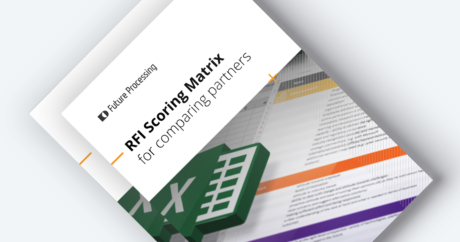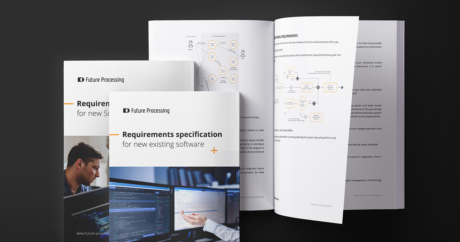What to include in an RFI to ensure you are provided with all the necessary details to best evaluate your potential IT suppliers? All the must-have aspects will be covered in detail in this article.
A Request for Information (RFI) for Software Development Outsourcing
A well-written Request For Information (RFI) will help you make the process of evaluating your potential software development partners time and cost-efficient. It will also help you ensure the technology services they offer align with your business’s needs.
To save you time, we created an ultimate RFI document template based on the numerous RFIs we received as a technology company over the last two decades.
What is an RFI Template?
Request for Information (RFI) is a standard procurement procedure used to gather information about potential suppliers’ skills and capabilities and compare them to make an informed business decision.
It is usually a replicable 3-to-5-page document that provides an executive summary of what is to be outsourced, along with details on a vendor’s specific capabilities.
Think of the RFI as an exploratory stage in the procurement process. An RFI is a formal request for information that is not binding on either the supplier or the purchaser. It is usually used before submitting specific requisitions for items. The main objective of an RFI is to become familiar with the current market for a particular product or service and to gather information in a structured, formal and comparable manner. It’s like casting a wide net to see what options are out there. It’s not always about having a defined problem with a known solution; sometimes, it’s about discovering potential solutions.
Why should you prepare an RFI for outsourcing IT projects?
In an RFI document, you’ll need to complete a section with information about your company. That’s why it’s best to start with an easily editable document format, such as Word doc, and save it as an editable PDF form to be completed by the companies you want to approach for information. To help you do this, the RFP template you can download using the form above is provided in the Word doc format.
Sending an RFI template to potential partners will help you explore the IT and tech market. You should gain a good overview of a proposed solution to your technology challenge through the RFI process without getting into too much detail. It’s a good first step to get a broader perspective on your technology problem and collect some innovative ideas from suppliers. An RFI will also help you gather information about the capabilities of various vendors to create a shortlist of companies to contact with an RFP.
Essential Elements of an Effective Request for Information Software Document
Our recommended Request For Information template form is divided into two main sections:
- Introduction
- Questionnaire
In the Introduction section, you should tell your potential partner who you are, what your area of expertise is and what goal you wish to achieve with this particular Request For Information (RFI) form.
Here’s a sneak peek of what’s included in the Introduction part of our downloadable RFI template.
This is only a preview – to see the entire list, download the RFI template in Word.
INTRODUCTION
1. Information about confidentiality and proprietary rights
2. Your background and general information
3. Project summary and goals
4. Required skills and competencies
5. Request For Information process
6. …..
The Questionnaire section collects information from the potential vendors on your shortlist. Here’s a preview of our RFI template – and because it’s an editable Word document, you can amend the questions to fit your company’s needs.
Again, remember this is only a part of a very high-level table of contents. The RFI template for download is much more detailed, with loads more sections and subsections.
QUESTIONNAIRE
1. Organisation
2. Experience
3. Project Management
4. Technical experience
5. Quality assurance
6. ….
A detailed RFI response is paramount when it comes to ensuring that business requirements are met with precision. By carefully addressing each component, companies can provide potential vendors with a comprehensive understanding of the project and their expectations.
- Describing the scope and nature of the IT project:
This component of the RFI document outlines the breadth and depth of the IT project. It offers potential vendors a clear understanding of the project’s goals, primary objectives, and the problems it aims to solve. - Detailing technical requirements, and expertise:
In this section, the company specifies the technical necessities, underlying infrastructure needs, and the specific expertise they’re looking for in a vendor. By laying out these details, organisations can be sure they’re attracting vendors with the right technical capability and knowledge to handle the project. - Setting the groundwork:
In this part of the RFI software document, the company lays out its expectations for the project’s timeline, budget, and deliverables. Potential suppliers can evaluate whether they can complete the project within the set parameters if they have a clear idea of what is expected of them from the outset. - Criteria for vendor evaluation:
Here, you detail the particular criteria that will be used to evaluate prospective vendors to ensure fruitful cooperation. A clear and objective vendor selection process requires well-defined attributes and benchmarks. - Company overview:
It’s important for potential suppliers to understand the company’s values, principles, and culture. By learning about its history, objectives, and core beliefs, vendors can determine how well they align with the company’s goals and working style.
Read more about:
A tool for comparing and selecting IT outsourcing partners
Best Practices and Strategies for a Transparent RFI Process
When engaging in recurring procurement projects, especially in the realm of IT services, having a well-crafted software RFI template can be a game-changer.
Some generic good practices to follow when preparing an RFI include providing relevant information about your business, asking precise questions or stating your needs clearly at the very beginning. It is also important to gather information in a formal and structured manner, as this will enable easy comparisons.
Transparency and providing equal opportunities are very impotrtant. Therefore, widely advertise the procurement process and the RFI to a diverse set of suppliers. This not only offers everyone a fair chance but also increases the possibility of getting a variety of innovative solutions.
Avoid changing requirements midway. If an amendment is absolutely necessary, ensure it’s communicated to all potential suppliers, giving them an equal opportunity to adjust their responses.
Another fundamental aspect of transparency is the evaluation criteria. Be clear about how submissions will be judged. This includes the weight given to different sections, preferred qualifications, or any other relevant metrics. Potential suppliers must know how their information will be assessed.
Lastly, remember that maintaining confidentiality is part of the transparency process. Suppliers trust you with their sensitive information, and ensuring it’s kept confidential upholds the integrity of the entire RFI process.
To discover more good practices, watch the 2-minute video below, where three technology leaders uncover their recommendations for the RFI process.
Common Mistakes in IT Outsourcing RFIs and How to Sidestep Them
When crafting RFIs, businesses often make mistakes that can undermine the outsourcing process. We will examine common challenges and provide recommendations to address them.
Overloading with irrelevant details
An RFI with too much irrelevant information can confuse vendors and obscure the primary objectives. Therefore, keep the document focused on the relevant and required data.
Lack of clear objectives
If an RFI lacks clear objectives or purpose, vendors may struggle to understand what the organisation is looking for, leading to mismatched responses.
Not considering vendor capabilities
It is essential to have a thorough understanding of the typical services and capabilities of IT vendors when creating an RFI template for software services. Failure to do so can result in unrealistic expectations and responses that do not align with actual market offerings.
No defined evaluation criteria
When organisations do not specify how they will evaluate responses, vendors might be unsure of what to emphasise in their replies. It can also make the organisation’s evaluation process longer and more subjective.
Ambiguous language
Using vague or jargon-filled language in the software RFI template can lead to misinterpretations, resulting in inaccurate or off-target vendor responses.
Not updating RFIs regularly
The IT landscape is ever-evolving, and an RFI that is not periodically updated might miss out on newer technologies or industry best practices, leading to outdated or less optimal solutions.
Neglecting stakeholder input
Ignoring internal stakeholder feedback can result in an RFI that misses key organisational needs or nuances, possibly leading to unsuitable vendor partnerships.
Setting unrealistic timelines
Demanding very tight response times can discourage thoughtful responses from vendors or deter some from participating altogether.
The Process Post-RFI Submission: How to Evaluate Responses Efficiently
When evaluating RFI responses, it’s important to ensure that the process is systematic, unbiased, and efficient. Here is a step-by-step guide to help you navigate through the evaluation process:
- Focus on key areas:
Pay attention to the most important areas that align with your organisation’s goals and the intent of the RFI. This will help you prioritise the most critical information. - Review the RFI requirements:
Go back to the original RFI and make sure you understand what’s required. This will help you make sure that your response meets the criteria. - Establish clear evaluation criteria:
Before you start evaluating, ensure you have a clear set of standards or benchmarks that you’re looking for. This can be a scoring system or a checklist that helps you stay consistent. - Standardize the format of responses:
It’s helpful if all the information comes in a similar format. This makes it easier to compare the responses and make sure you don’t miss anything important. - Score responses:
Assign scores to each response. This will help you compare them objectively and rank them based on how well they meet your criteria. - Compare responses:
Once you’ve standardised and scored the responses, put them side-by-side for a comprehensive review. This will help you see the strengths and weaknesses in each response. - Finalise decision and provide feedback:
Based on your analysis and scoring, decide on the most suitable responses. It’s also a good idea to give feedback to all the respondents and explain why you made the decisions you did. This helps promote transparency and can guide vendors in future RFIs.
How to write RFI for IT projects? With our Free Template!
As you can see, preparing a good RFI for software development solutions is not an easy process. To save you time and make life easier, we created an RFI template as a Word document, ready for you to download and edit. The template is based on the RFIs we’ve received over the last 20 years from our clients. So go ahead and download now (it’s free!)
Also check out our other downloadable materials that you may find useful:



